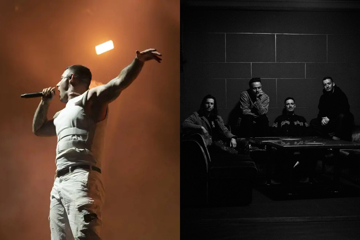Album Review: The Go-Betweens - G Stands For Go-Betweens: Volume 1
"A gargantuan and exhaustive collection of both music and memories"

If you (quite reasonably) imagined that there was nothing new to add to story of Australian indie darlings The Go-Betweens at this late stage then the new boxset G Stands For G-Betweens – Volume 1 proves you spectacularly wrong. It’s a gargantuan and exhaustive collection of both music and memories, ranging from the Brisbane band’s humble beginnings in 1978 through to the release of their third long-player Spring Hill Fair in 1984 – as such covering roughly the first third of the band’s venerated career. The boxset contains four vinyl albums – The First Five Singles, Send Me A Lullaby (1982), Before Hollywood (1983) and Spring Hill Fair (1984) – which have all been re-mastered, these re-pressings their first release in three decades. Then there are four additional CDs of demos, off-cuts and live tracks from the period, as well as a treasure trove of information and archival artifacts from the era.
THE FIRST FIVE SINGLES
The first five singles from The Go-Betweens came at a time when 7" singles still had massive currency, so these early statements hold far more import than they might in later decades. This was also just after bands like The Saints and Radio Birdman had paved the way for independent releases, so the fact that they were initially releasing their music through their own small independent Able Label in the inner-Brisbane suburb of Toowong is also important. This collection represents one 7" single per year between 1978-82, with the A-sides being Lee Remick, People Say, I Need Two Heads, Your Turn, My Turn and Hammer The Hammer. In the early stages of the band Robert Forster was still in creative control and in the process of teaching his partner-in-crime Grant McLennan how to both play bass and write songs, with the final single here Hammer The Hammer being described in the liner notes as “McLennan’s first great pop song and A-side lead vocal” so it’s clear that he learned the ropes quite quickly. All five B-sides are strong tracks in their own right (especially their opening gambit, Karen), this early period of the band fascinating as they explored their own sound and musical relationship with a premium seemingly placed on space, melody and pop nous.
SEND ME A LULLABY
While The Go-Betweens as a unit had no doubt gained confidence from the traction gained by the early singles, they were still very much a work in progress and the sessions for their debut long-player represent the first time that they’d ever tackled more than two songs at once. Still, their naked creative ambition was obvious early in the way that they eschewed traditional structures in search of their own sound and feel, the songs relatively brief and angular as they explored the realms of art-infused post-punk. The drumming of relatively new addition Lindy Morrison – who would in time become so important to the band dynamic – is quite prominent even this early in the piece, and even at this nascent stage the way that the differing styles and worldviews of Forster and McLennan complement each other is obvious. Sometimes viewed as the red-headed step-child of The Go-Betweens’ catalogue – oft-overlooked by both the band and fans – this re-mastering of Send Me A Lullaby proves that there’s plenty to sink your teeth into in both the style and substance stakes. Oddly, James Freud played saxophone on People Know.
Don't miss a beat with our FREE daily newsletter
Key tracks: One Thing Can Hold Us, People Know, Eight Pictures, Hold Your Horses
BEFORE HOLLYWOOD
The band had found themselves at a dead-end in Melbourne when Rough Trade Records from London asked to license Send Me A Lullaby for the rest of the world, opening the door for them to do a second album directly with Rough Trade. They spent five months in London writing and rehearsing, and the introduction of fledgling producer John Brand represents the first time that The Go-Betweens had worked with someone outside the band overseeing this side of the recording process. Both Forster and McLennan were flourishing and finding their respective voices, but it was the latter’s Cattle And Cane which really created a stir and became the band’s first ‘hit’. This song seems like blatant Australiana at its core but there’s a sentimental universality which obviously endeared the song to people everywhere, the song reaching #4 on the UK independent charts (the album bettering that by peaking at #2). The music throughout Before Hollywood still retains the post-punk vibe of their debut in places but expands their palette into more melodic folk, so as well as being The Go-Betweens’ first lauded ‘classic album’ it also plays an important role in establishing the sound that would serve the band so well in later years.
Key tracks: Cattle And Cane, By Chance, Dusty In Here
SPRING HILL FAIR
We looked at this album in some depth recently for its 30th anniversary, examining their move to Sire Records (after Rough Trade had been unable to afford further funding) and how they’d been shipped to France to record their third album (with Brand once more at the production helm) but were eventually scuppered to a degree by the label’s desire for a “contemporary ‘80s sound”. Furthering the problems, the camaraderie between the band members had reportedly dissolved into something near acrimony (although new bassist Robert Vickers had joined the ranks and allowed McLennan to move to guitar and expand the band’s live range), so it’s testament to their creative bent that they still emerged with this great artistic statement. Unlike the predecessor, there’s no one standout song, yet both McLennan and Forster submitted some iconic work for the album and despite the adversity surrounding its genesis it remains a beautiful collection of songs (although the print reviews included in the boxset suggest that the album’s stylistic shift was jarring for many people drawn in by the relatively lush tones of Before Hollywood).
Key tracks: Draining The Pool For You, Bachelor Kisses, Part Company, Man O’ Sand To Girl O’ Sea
CD 1 – LIFE AS SWEET AS LEMONADE: Rarities Volume One 1978-1979
This disc of unreleased early material is a treasure trove for hardcore fans, their nascent music simple but promising and with an ingrained elegance (no ramshackle beginnings for The Go-Betweens). It features early line-ups of the band, hence we find names like Peter Walsh (later of The Apartments) and drummers Tim Mustafa and Bruce Anthon amongst the credits. A lot of the material here is literally the band trying to define their sound and many of these early songs were never even played live, and there’s a real pop bent on display as they searched for attractive melodies and hooks. The 22 tracks were all recorded between late 1978 and late 1979 (some in a suburban Toowong house by Gerry Teekman on a cassette recorder), and it’s both a fascinating glimpse into the band’s early mindset and of a surprisingly high standard – primitive versions of tracks like Don’t Let Him Come Back and Eight Pictures sound remarkably fully formed, whilst Big Sleeping City is the first-ever Forster/McLennan co-write (McLennan penning the foundation bass riff).
CD 2 – SKELETONS THAT CRY: Rarities Volume Two 1980-1981
This disc of unreleased music from around the Send Me A Lullaby era finds The Go-Betweens settling into their eventually established structure – McLennan now contributing equally to writing and Lindy Morrison now comfortable behind the kit – although in the disc’s liner notes Forster admits to “struggling in [his] role as songwriter and guitarist” as the band morphed from its early incarnation. It’s still a very fertile era, however, as Skeletons That Cry effortlessly showcases; the band had joined forces with the Postcard label crew on their first trip to the UK (via a vaguely fortuitous hook-up at the Rough Trade record shop) and eventually played their very first shows outside Queensland in Glasgow – the version here of Don’t Let Him Come Back is from their third overseas show (again in Glasgow). They returned home only to find themselves stuck in Brisbane as I Need Two Heads/Stop Before You Say It started denting the indie charts in the UK, and the ensuing frustration is palpable (the final track here, Red Epaulettes, is from their farewell Brisbane show in October ’81 as they moved to Melbourne). Probably the most fascinating material here is a group of songs that they demoed for the Send Me A Lullaby session which never made the cut, including some fascinating McLennan compositions (I Know Why, Circle You) plus interesting versions of songs which would eventually be re-recorded (One Word, All About Strength).

CD 3 – LIVE 82: Rarities Volume Three
This full live set was recorded at the Mosman Hotel in Sydney on 23 April 1982, and captures The Go-Betweens (who had by now relocated to the Victorian capital) taking on Sydney during their first-ever national headlining tour. They were supporting both Send Me A Lullaby and new single Hammer The Hammer and even though there’s clearly not a massive throng before them in the suburban pub the trio is playing fervently and with great conviction, clearly not hampered by a lack of self-belief. One thing that’s noticeable from the tracklisting is that they’d already jettisoned the early “jangly” material and were focusing on tunes from the previous 18-24 months, plus they’d already introduced a heap of new material into the set: Metal And Shells would eventually morph into the title-track from the next long-player Before Hollywood, but one Forster number (Undo What You Did) and two of McLennan’s (Distant Hands and Near The Chimney) disappeared altogether in the six months before that next album, testament to the creative wave that the trio were riding at the time. All that aside it’s just fascinating hearing them onstage in full flight at this juncture, already an impressive live unit so early in the piece.
CD 4 – A SUICIDE NOTE TO SATAN: Rarities Volume Four 1982-84
This final disc is a veritable treasure trove, comprising 23 tracks from the two-and-a-half years leading up to the release of Spring Hill Fair. It contains a live recording from Zurich which represents their first recordings as a four-piece (after the addition of Robert Vickers to bass), nascent versions of much-loved songs (Cattle And Cane, Bachelor Kisses), as well as B-sides and more demos which never made the cut on the eventual albums they were (presumably) penned for; some songs disappear from the canon entirely, while others eventually end up as bits and pieces of later songs. Of particular interest is the band’s Peel Session from late 1984, which not only has a version of Five Words with different lyrics, but also the track The Power That I Now Have which eventually birthed both Head Full of Steam and To Reach Me. A live version of Forster’s previously unheard For Him is also a delight, but basically it’s a deep and rewarding excursion from start to finish – the scope and quality of the material here is quite staggering given that it’s found in a boxset of predominantly unavailable music.
additionaL MATERIAL
All good boxsets have a wealth of non-musical material for die-hard fans to sink their teeth into, and G Stands For Go-Betweens – Volume 1 is no exception. The old press releases and posters from the band’s very earliest forays are a nice touch, but it’s the tome The Go-Betweens Anthology: Volume 1 — 1978-1984 which ultimately proves the pièce de résistance.

The extensive recollections by Robert Forster give a poignancy that only first-hand accounts can provide, all told as a third-person narrative which becomes a fascinating vehicle for him to place everything in context of the band’s development. It traces their journey from a pair of music fans at the University Of Queensland to a fully-fledged band who quite literally willed themselves onto the world music scene with a stunning mix of idiosyncratic music and unchecked creative ambition. Along the way, he corrects misconceptions about the band’s formation: they didn’t start in 1977 as history often shows (the seeds may have been sown in ’77 but McLennan didn’t return to Brisbane and buy a bass until the following January) and also the name wasn’t directly lifted from J.P. Hartley’s 1953 tome The Go-Between as is often intimated.
Their legendary first gig as a duo at Baroona Hall in recounted with great insight, and it paints a relatively harmonious relationship between the band and their native Brisbane (unlike the hubris displayed by many of their peers and contemporaries and often ascribed to The Go-Betweens as well). It tells of their rampant early aspirations – relocating to the UK without an album and with only two singles to their name – and puts forward a counter view to the myth that The Go-Betweens were “unsuccessful” and had little luck – Forster is adamant that this is not (nor ever was) the band’s worldview in the slightest. There are tales of their various forays to Europe, meeting peers and people whose work they admired, a trip to New York City (the band’s “spiritual home”) and plentiful accounts of what can only be described as “idyllic times” – these are tales of great friends having adventures and seeing the world as they played the music they loved, not of hopes and dreams being jettisoned amidst melancholy.
The beautiful coffee-table sized book also contains a wealth of rare archival photos, plus a series of pieces and essays on the band by accomplished writers such as Clinton Walker, Peter Walsh, Ryan Maffai and more, giving slightly more objective (and often equally fascinating) opinions on this early era of The Go-Betweens. A discography and some random McLennan poetry from 1980-82 makes this book alone an absolute Valhalla for fans of this great act.
The whole package combines wonderfully into a verdant landscape of beautiful music, rich lyrical imagery and tales of real life characters who loom large but veer towards being interesting rather than intimidatory. It’s not all gold, but what band could bare the fruits of its entire genesis to the world in this manner without the occasional misstep? And as this is but the first boxset of an eventual three – The Go-Betweens’ life cycle lends itself nicely to being split into thirds – the literature accompanying Forster’s memories of the Volume 1 era ends on a cliffhanger note; having completed a massive three-month tour of Australia in support of Spring Hill Fair (ascertaining that it was possible to tap into the nascent pub circuit which was beginning to blossom and suddenly providing a thriving and financially viable ‘alternative’ scene in Australia), they’ve just been dropped from their label Sire (this band either had the worst run of luck with record labels in history or their diplomacy, tact and social skills need to be questioned) but remain desperate for international acknowledgement and acceptance and vow to return to the relatively risky climes of London. At this juncture they have no money, manager nor label, Forster concluding with, “It was one of the band’s finest moments”. So will our heroes prevail? Bring on Volume 2!
NB: Original orders of the boxset (600 only, which have all sold out) came with a book from the personal library of the much-missed McLennan – who passed away tragically in 2006 – with a signed bookmark from Forster acting as provenance to authenticity. The book received by this scribe (from personal purchased boxset rather than review material) was a hardcover version of the novel Gould’s Book Of Fish (2001) by Tasmanian author Richard Flanagan. It’s an incredibly moving, albeit devastatingly sad, personal touch.







